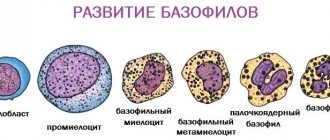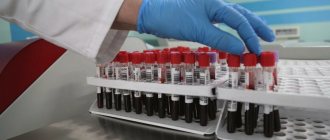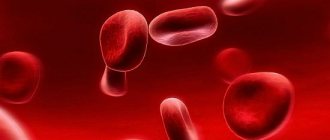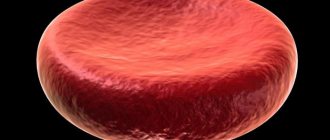What is a biochemical blood test?
Blood is a unique substance in the human body for detecting certain defects in the human body. It is present in all organs and tissues, therefore it includes many different substances that are formed during their work.
Biochemistry quite accurately helps to determine the presence and level of these substances and, by comparing the data obtained and fixed standards, learn about the state of the body and the causes of possible diseases. In some cases, this study is the last option the doctor has to confirm the disease.
In addition to diagnostic purposes, biochemical analysis is used in many specialized medicine to determine specific indicators. The study uses blood from a peripheral vein. As a rule, blood is taken from the veins located near the elbow joint. However, when access to a given site is impossible, for example, in case of a fracture, any other site is suitable.
The place from which the sample will be taken is treated as in any other case in which the surface of the epidermis is damaged (with a disinfectant). To obtain results, 5 to 10 ml of blood are sufficient, which are collected in a special tube.
Proteins in blood
Total protein is low in the blood (the reasons for this often lie in the development of pathology of internal organs) occurs in children and adults. A close relationship between indicators and the state of the body is observed due to the importance of protein metabolism in the human body.
Proteins perform a number of important functions:
- Construction Proteins are involved in the formation of new body cells.
- Metabolism.
- Maintaining immune protection.
- Regulation of oncotic pressure.
- Maintaining hemostasis (constancy of the internal environment of the body).
- Digestive (digestion of food).
- Transfer of nutrients to body tissues.
- Energy (proteins enter the body with food and saturate with energy).
- Regulatory.
Indications for analysis
As a rule, a biochemical blood test is prescribed to women by a doctor for diagnostic purposes, when violations of the norms are detected in the functioning of certain organs , or the general condition of the patient. The procedure is also carried out to check the quality of the prescribed treatment for already identified diseases. At the same time, the list of necessary indicators is determined by the doctor individually for each case.
Indications for analysis may include problems with the following organs:
- liver;
- kidneys;
- biliary system;
- endocrine system;
- blood systems;
- Gastrointestinal tract;
- musculoskeletal system.
In combination with some other procedures, biochemistry makes it possible to identify the correct pathology of almost any organ.
Preparing for blood collection
To obtain correct data, blood donation must be carried out following some important rules:
- The procedure must be carried out on an empty stomach, and fasting should be at least 8 hours, but not more than 13 hours. Therefore, the most favorable time for the study is from 8 to 11 am. 1-2 days before the procedure, you should avoid heavy foods and any drinks other than water.
- When taking any medications, you should check with your doctor whether it is necessary to stop taking the medication and the duration of abstinence.
- 24 hours before donating blood, you should avoid any amount of alcohol consumption, and stop smoking at least 1 hour before your appointment.
- 72 hours before the test you need to isolate yourself from stress (both emotional and physical). Once you are at the place where the analysis is being carried out, you should sit quietly for a while before entering the office.
- If a repeat study is necessary, it is advisable to conduct it in the same institution.
Preparation and analysis procedure
Blood for analysis must be taken from the ulnar vein
Before taking a blood test to determine total protein levels, it is important for the patient to prepare properly. This will help to obtain sufficiently reliable data and establish an accurate diagnosis:
- First of all, it is important to know that the test is taken on an empty stomach. Eating should be avoided 12 hours before blood collection.
- On the eve of the study, drinking juices, coffee, tea and carbonated drinks is also unacceptable. On the day of blood collection, you are allowed to drink boiled water.
- The day before the test, you should avoid fatty, fried and salty foods. Alcohol should not be consumed two days before the blood test is taken.
- In the morning, on the day of delivery, it is not recommended to smoke.
- Physical activity should also be avoided the day before the laboratory test. It is necessary to inform the doctor about taking medications.
Blood is drawn from a vein to determine the total protein level. The patient must follow all doctor's recommendations. First of all, the specialist will ask you to clench and unclench your fist in order to do this. So that the vein fills with blood. Then the laboratory assistant makes a puncture on the elbow with a special needle, and attaches a test tube to it. After this, blood is drawn.
After the procedure, you should bend your arm at the elbow for five minutes. Immediately after the procedure, it is not recommended to go outside immediately. Patients should sit near the office for 10-15 minutes. If you feel unwell during blood sampling, you need to inform a specialist.
Useful video about blood protein testing:
Norm by age and gender
The normal content of total protein depends on the age and gender of the patient.
| Category | Women (g/l) | Men (g/l) |
| Newborns | 42-62 | 41-62 |
| 0-1 year | 45-80 | 46-70 |
| 1-4 years | 60-74 | 54-75 |
| 5-7 years | 54-80 | 51- 79 |
| 8-17 years | 60-76 | 55-79 |
| 22-33 years old | 75-80 | 82-84 |
| 34-60 years | 78-83 | 75-80 |
| 61-75 years old | 74-78 | 75-78 |
| Over 75 years old | 68-77 | 73-77 |
If the indicators change, the specialist will find out the reason for the increase or decrease in the level of total protein.
Decoding the analysis results
Since the norm of a biochemical blood test in women differs significantly from the norm in men, doctors first determine the gender of the patient. The same thing happens with age.
This process is an analysis of the comparison of existing standards for certain indicators and the data obtained during diagnostics. The analysis is carried out on a special form - a table containing all the indicators that are determined by the biochemical laboratory.
A ready-made table with the results is provided to the patient, from which he can find out the ratio of his indicators to the norm. The decryption process generally occurs quite quickly: within 2-3 days. Also, in the modern world, decryption can be done independently using special online platforms on the Internet.
If any indicators deviate from the norm, the doctor prescribes additional examinations to determine the most accurate diagnosis.
Interpretation table for biochemical blood tests in adults
| Indicator in the study | Norm |
| Total protein | 63-87 g/l |
| Protein fractions: albumin globulins (α1, α2, γ, β) | 35-45 g/l 21.2-34.9 g/l |
| Creatinine | 44-97 µmol per l – in women, 62-124 – in men |
| Urea | 2.5-8.3 mmol/l |
| Uric acid | 0.12-0.43 mmol/l - in men, 0.24-0.54 mmol/l - in women. |
| Total cholesterol | 3.3-5.8 mmol/l |
| LDL | less than 3 mmol per l |
| HDL | greater than or equal to 1.2 mmol per L - in women, 1 mmol per L - in men |
| Glucose | 3.5-6.2 mmol per l |
| Total bilirubin | 8.49-20.58 µmol/l |
| Direct bilirubin | 2.2-5.1 µmol/l |
| Triglycerides | less than 1.7 mmol per l |
| Aspartate aminotransferase (abbreviated as AST) | alanine aminotransferase - normal in women and men - up to 42 U/l |
| Alanine aminotransferase (abbreviated as ALT) | up to 38 U/l |
| Gamma glutamyl transferase (abbreviated GGT) | normal GGT levels are up to 33.5 U/l in men, up to 48.6 U/l in women. |
| Creatine kinase (abbreviated as KK) | up to 180 U/l |
| Alkaline phosphatase (abbreviated as ALP) | up to 260 U/l |
| α-amylase | up to 110 E per liter |
| Potassium | 3.35-5.35 mmol/l |
| Sodium | 130-155 mmol/l |
Biochemistry standards for women by age: table
| Substance | Indicators | Normal for women | Notes |
| Squirrels | Total protein | 64-83 g/l | Children under 17 years old: 47-73 g/l Over 60 years old: 62-81 g/l |
| Albumen | Z5-50 g/l | For women over 60 years old: 34-38 g/l | |
| C-reactive protein | Up to 0.5 mg/l | ||
| Myoglobin | 13-76 µg/l. | ||
| Rheumatoid factor | 0 | ||
| Ferritin | 1З-400 µg/l | Children may have different indicators | |
| Enzymes | AlAT | Up to 31 U/l | |
| ASAT | Up to 31 U/l | Children under 18 years old have different indicators | |
| Alpha amylase | 27-100 U/l | ||
| Phosphatase alkaline | Up to 240 U/l | ||
| Lipids | Triglycerides | 35-40 years – 0.45-1.99 40-45 years – 0.51-2.16 45-50 years – 0.52-2.42 50-55 years old – 0.59-2.63 55-60 years old – 0.62-2.96 60-65 years – 0.63-2.70 | |
| Total cholesterol | 3-6 mmol/l | ||
| Cholesterol–HDL | 0.8-2.2 mmol/l | ||
| Cholesterol - LDL | 1.92-4.51 mmol/l | ||
| Carbohydrates | Glucose | 3.88-5.83 mmol/l | For women 60+: up to 6.38 mmol/l |
| Fructosamine | 0-285 µmol/l | ||
| Pigments | Total bilirubin | 3.4-17.1 µmol/l | |
| Direct bilirubin | 0-3.4 µmol/l | ||
| Nitrogenous components | Creatinine | 53-97 µmol/l | |
| Uric acid | 150–350 µmol/l | In children 120–320 µmol/l | |
| Urea | 2.2–6.7 mmol/l |
Normal indicators during pregnancy
Pregnant women experience enormous changes in their bodies, so the norms for biochemical blood tests in some categories differ from those of other patients. When carrying a child, some criteria change.
Changes for the 3rd trimester:
- increase in globulin;
- decrease in urea;
- increased phosphatase.
Towards the end of pregnancy:
- decreased creatine;
- slight decrease in potassium;
- decreased magnesium;
- decreased iron levels;
- Albumin levels can be altered in both directions.
The norms for biochemical blood tests in pregnant women differ from the standard ones in some categories.
Such changes are normal and are associated with physiological changes in the body of the expectant mother. The remaining indicators in pregnant women should remain unchanged, which will indicate a positive pregnancy, as well as the health of the mother and baby.
Norms of microelements in women
Each of the microelements is an important component of a woman’s body, contributing to its proper functioning. Therefore, they must be treated with due care.
Standard microelements that can be seen using biochemistry include:
- Sodium. Promotes the absorption of calcium, participates in the reaction of the skin to external irritants. Deviations from the norm may indicate the presence of diabetes, urinary tract problems, kidney or liver failure (134-143 mmol/l);
- Potassium. Responsible for the work of the heart. Non-compliance with fixed indicators may indicate problems with blood vessels, gastrointestinal tract organs, diabetes and cancer (3.5-5.3 mmol/l);
- Chlorine. Participates in normalizing the pH of the circulatory system. Non-compliance with fixed indicators may indicate the inoperability of many organs, lack of fluid in the body, or hormonal imbalances. (93-113 mmol/l);
- Phosphorus. Promotes the normal functioning of various human tissues. (1.43-2.13 mmol/l up to 2 years; 1.43-1.78 mmol/l up to 13 years; 0.87-1.43 mmol/l less than 60 years; 0.93-1.32 mmol/l for the elderly);
- Magnesium. Promotes the normalization of processes at the cellular level, is responsible for the reaction of muscle tissue to external stimuli. Non-compliance with fixed indicators may indicate diseases of internal organs, as well as ill-conceived nutrition (0.66-1.03 mmol/l);
- Iron. Responsible for the normal functioning of the gastrointestinal tract and normalization of metabolism (8.9-30.03 mmol/l in the elderly; 9-23 mmol/l up to 14 years; 7-18 mmol/l up to 2 years);
- Calcium. Responsible for the functioning of various internal systems, also takes part in the formation of bones. Non-compliance with the norm may mean a lack of vitamins, ill-conceived nutrition, diseases of human organs and systems (2.13-2.6 mmol/l);
- Zinc (13-18 mmol/l);
- B9 (3-17 ng/ml).
In some cases, indicators may deviate from the norm, for example, during pregnancy. Therefore, you should not make premature conclusions on your own, but entrust this to a specialist.
Biochemistry indicators
Squirrels
- Total protein. A blood test for biochemistry can identify problems with metabolism and nutrition, the presence of cancerous tumors, and diseases of vital organs in women with abnormalities in total protein.
- Albumen. This protein occupies up to 63% of plasma and can tell about many diseases.
- Glycated hemoglobin. This protein is important for diagnosing diabetes and monitoring the effectiveness of treatment for it. The content norm is 5.7%. If this indicator is reduced to 6.3%, then there is a risk of developing this disease; a lower percentage indicates the obvious presence of diabetes.
- Myoglobin. A high content and increase of this protein in the blood may indicate serious diseases of the heart muscle. Analysis for this component is considered mandatory for patients with suspected myocardial infarction.
- Rheumatoid factor. The presence of even 1 unit of this protein in the analysis indicates possible diseases, including cancer.
- C-reactive protein. The function of this component is to improve the functioning of the body's defense reactions. A slight increase may be considered normal when using capsule contraceptives.
- Ferritin. The norm for the element in a biochemical blood test is considered to be 13-400 mcg/l in mature women. An increase or decrease in this protein is a consequence of a lack or excess of iron in the blood, which can lead to serious health problems.
Carbohydrates
- Glucose. The main task of this element is to saturate the body with energy. Deviations from these numbers may be the result of diabetes, pancreatic cancer, or a reaction to certain medications.
- Fructosamine . This component combines protein and glucose.
Enzymes
- AlAT. A liver enzyme involved in the process of amino acids. Deviations from the norm may indicate problems with the heart and blood vessels, as well as liver diseases.
- Amylase. It originates in the salivary glands and is involved in the breakdown of carbohydrate compounds.
- Pancreatic amylase. It is also of great importance in the breakdown of carbohydrates. An increased content of this element may indicate problems with the pancreas.
- ASAT. Large amounts of this enzyme can be found in the blood for various liver problems.
- Gamma-glutamyltransferase . This enzyme occurs in connection with the functioning of the pancreas and liver. An increased amount of it in the blood indicates excessive drinking, as well as liver disease.
- Creatine kinase. An increased concentration may indicate the presence of kidney failure, myocardial damage and systemic connective tissue pathologies.
- Lactate. The enzyme is a product of carbohydrate metabolism, indicating the lack/sufficiency of oxygen in the tissues. An increased concentration of the enzyme indicates excessive use of certain medications, as well as many diseases of the internal organs.
- Lactate dehydrogenase. Participates in the formation of the previous enzyme. Deviations from the norm may occur in newborns and pregnant women, but this is considered normal. In other cases, an increase in the enzyme level in the blood can be caused by diseases of the liver, kidneys, and blood supply system.
- Lipase. Participates in the process of fat breakdown. Deviations may indicate various problems: from poor nutrition to diseases in the field of oncology.
- Alkaline phosphatase. Stimulates metabolic processes with phosphorus.
- Cholinesterase. Occupies an important place in ensuring the functioning of nerve and muscle tissues. Non-compliance with the norm can be caused by many serious diseases: cancer tumors, liver pathology, diabetes, manic-depressive syndrome, etc.
Pigments
Total bilirubin . Responsible for coloring the skin and mucous membranes. Includes:
- Direct bilirubin, deviations of which may indicate problems with the biliary tract and liver.
- Indirect bilirubin is a breakdown product of hemoglobin, the work of which can be seen when the color of the bruise changes.
Lipid spectrum
- Triglycerides. This element enters the blood through the synthesis of carbohydrates from the liver and their nutritional elements. Norms vary significantly depending on the gender and age of the patient, as well as in pregnant women. Deviations from the norms can be recorded due to diseases of the cardiovascular system, thyroid gland, liver, as well as in the presence of diabetes.
- Total cholesterol. It is the value of the sum of “positive” and “negative” cholesterol.
- Cholesterol–HDL (“positive”) . Helps in determining predisposition to atherosclerosis, processes and removes fats from the body.
- LDL cholesterol (“negative”) . The function of this element is to distribute cholesterol throughout the body, which comes with food. An increase in it in the blood indicates the presence of problems.
Nitrogenous components
- Creatinine. Produced through protein metabolism, it is excreted from the body in urine. A decrease in the substance in the blood is an indicator of nutritional problems, and an increase means pathology of the kidneys and thyroid gland.
- Uric acid. It originates in the liver and is removed from the body in the same way as creatinine. Deviations from the norm can be caused by poor nutrition, alcohol abuse, kidney and liver diseases.
- Urea. It appears in the body as a result of the breakdown of ammonia. Non-compliance with the norm may occur in pregnant women and people leading a vegetarian lifestyle, as well as as a result of kidney and liver diseases.
Pregnancy connection
The standard value for protein content in the body of a pregnant woman has even more expanded boundaries. Sometimes this indicator in a pregnant woman can decrease by 30% of the usual norm. The normal level for a pregnant woman is considered to be 65-85 g/l, approximately the same level as for an ordinary pregnant woman. An alarming signal is a decrease in the indicator to 50 g/l.
For a pregnant woman, it is important to maintain this indicator at normal levels, as this affects the development of the fetus, its gestation and the protection of the mother’s body from various diseases. If the protein level is slightly below normal, this may be due to a tight tourniquet or improper collection of material for examination. However, a large difference in indicators may also be a consequence of pathologies such as:
- Liver diseases.
- Various forms of poisoning.
- Kidney disorders.
- Intestinal problems.
- Hereditary disposition.
- Poor nutrition or starvation.
- Imbalance of fluid in the body.
- Oncological diseases.
- Autoimmune diseases.
Article on the topic:
An increased level of basophils - what does it mean? Symptoms and causes.
Often the reason for a low level of this indicator can be a lack of protein products in a pregnant woman’s diet. Eating enough of these products will naturally increase your rate. These include seafood, milk and its derivatives, nuts, eggs, sausage and others. To preserve and maintain her health and the development of the fetus, a pregnant woman needs to monitor her diet and be responsible for all doctor’s instructions.
If the level of protein in a pregnant woman's body is elevated, this may be a signal of the presence of cardiovascular or kidney diseases. Its increase is often observed in women who smoke, so you should get rid of this bad habit several months before your planned pregnancy.
Protein: causes of deviations from the norm
The first thing you need to know when analyzing deviations from the protein norm is that they can be of three types:
- Relative. Depends on the amount of water that circulates in the blood. The indicators can be affected by both lack and excess of fluid.
- Absolute. Associated with changes in the rate of protein turnover, which can be caused by pathogenic processes or physiological processes, such as pregnancy.
- Physiological. Can be caused by any changes or stress on the body: pregnancy, lactation, hard work with your hands, heavy consumption of food with a high concentration of protein. This type of deviation is in no way related to pathological processes in the body.
Deviations can be either downward or upward, which is due to various reasons.
A decrease in protein levels can be caused by the following cases:
- Parenchymal hepatitis;
- chronic bleeding;
- anemia;
- kidney disease, which causes protein loss during urination;
- poor nutrition, consuming insufficient amounts of protein foods;
- problems with the metabolic process;
- various intoxications;
- fever.
A decrease in protein that is not associated with illness can occur due to pregnancy (last trimester), preparation of an athlete for competitions, or a sedentary lifestyle.
Unlike a decrease in the amount of protein in the blood, its increase has nothing to do with physiological abnormalities . If this indicator increases, the patient immediately requires examination and supervision of the attending physician.
Reasons for increased protein in the blood include:
- Hepatitis;
- cirrhosis of the liver;
- lupus;
- cholera;
- excessive bleeding, etc.
Why do you need protein?
Proteins are an integral part of blood plasma, that is, its liquid part, which does not contain cellular elements. When entering the body with food, proteins become the basis for the formation of enzymes, hormones and many antibodies. Proteins are unique carriers of vitamins, minerals, hormones and other substances in the blood, thereby ensuring the transport of these elements inside cells.
The concentration of certain types of protein in the blood determines the level of water in it and its ability to be retained in the blood, ensuring the elasticity of body tissues. In addition to all of the above, proteins ensure normal acid-base balance in the body, and are also considered a source of energy when there is a lack of nutrients in the body.
Article on the topic:
Elevated leukocytes in the blood of women - causes and consequences
The content of total protein in the body is considered an important diagnostic indicator for various diseases associated with metabolic disorders.
Glucose: causes of low and high levels
A high concentration of glucose in a person’s blood can be caused by problems:
- endocrine system;
- pancreas;
- liver and kidneys;
- diabetes;
- hemorrhages in the brain or heart.
In the case of low glucose, you can add to the above reasons:
- insulin overdose;
- oncology;
- poisoning with alcohol or chemical products;
- steroid use;
- hard physical work.
Don't miss the most popular article in the section: Fashionable bangs of the new season for medium, short, long hair. Photo.
What does the level of slag indicate?
Slags, also known as products of nitrogen metabolism, are very toxic and their increase in the human body can have serious consequences. The increase in waste can be caused by various reasons, but there is always some pathological process hidden in them:
- serious kidney and liver diseases;
- diabetes;
- gout;
- dystrophy and many other pathologies.
A decrease in waste, as a rule, does not carry serious causes and consequences, but it also requires checking with a doctor, as it may turn out to be, for example, liver failure.
Diagnosis of possible violations
Using a blood test for biochemistry, you can diagnose many problems and pathologies in the human body, but deviation from the norm, especially in women, does not always carry a dangerous omen. The same pregnancy can affect many indicators, which should not be considered something bad.
To confirm or refute a possible diagnosis, after deciphering, the attending physician will prescribe additional tests, and also advise which specialists should be visited and what should be changed in lifestyle and diet to restore normal biochemistry parameters.
Treatment
There is no special treatment to bring protein levels back to normal. The main principle for normalizing protein is to review your diet, reduce physical activity and get proper rest. In order to compensate for the deficiency of protein in the blood, it is necessary to increase the concentration of proteins and compensate for this deficiency. This can be done with medications and special diets.
Accordingly, to reduce protein it is necessary to increase physical activity on the body and use a special diet aimed at reducing the level. Any prescription and therapy must be carried out under the supervision of a specialist.











